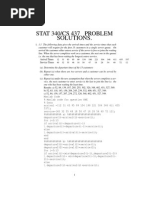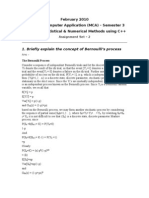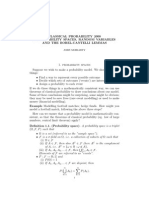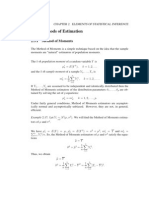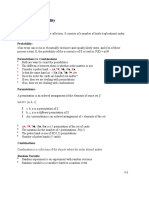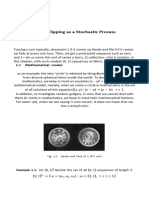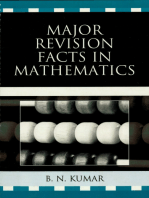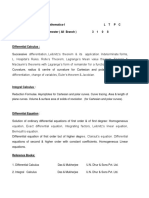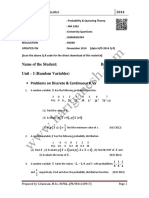Discrete Random Variables (Chapter 3) : Example 1
Discrete Random Variables (Chapter 3) : Example 1
Uploaded by
Shivneet KumarCopyright:
Available Formats
Discrete Random Variables (Chapter 3) : Example 1
Discrete Random Variables (Chapter 3) : Example 1
Uploaded by
Shivneet KumarOriginal Description:
Original Title
Copyright
Available Formats
Share this document
Did you find this document useful?
Is this content inappropriate?
Copyright:
Available Formats
Discrete Random Variables (Chapter 3) : Example 1
Discrete Random Variables (Chapter 3) : Example 1
Uploaded by
Shivneet KumarCopyright:
Available Formats
STAT2001_CH03A Page 1 of 10
DISCRETE RANDOM VARIABLES (Chapter 3)
A random variable (rv) is a numerical variable whose value depends on the outcome
of an experiment.
Notes: A random variable must be a number; it cannot be a letter, say.
More precisely, a random variable is a real-valued function for which the
domain is a sample space (Definition 2.12 on page 76 in the text).
Example 1
A coin is tossed twice and the sequence of Hs and Ts is observed.
(Recall that an experiment consists of two things: what is done, and what is observed.)
Let Y be the number of Hs which come up.
Show that Y is a random variable.
The experiment here has 4 possible outcomes: TT, TH, HT, TT.
Also:
Y = 0 if the outcome is TT
Y = 1 if the outcome is TH or HT
Y = 2 if the outcome is HH.
We see that Y is a numerical variable whose value depends on the outcome of an
experiment. Therefore Y is a random variable.
A random variable is discrete if its possible values are either
finite or countably infinite in number (or in other words, if those values can be listed).
For instance, Y in Ex. 1 is a discrete random variable (because {0,1,2} is a finite set).
Notes: If the possible values of a rv Y are 0,3,6,..., then Y is discrete.
If the possible values of Y are all the real numbers in the set (3,7),
then Y is not discrete; in this case we say that Y is a continuous rv (see Ch 4).
There is another type of random variable which is neither discrete nor continuous
but a combination of both types; such a r.v. is said to have a mixed distribution.
This may be covered later in Chapter 4 (e.g. see Example 4.19).
STAT2001_CH03A Page 2 of 10
The probability that a discrete random variable Y takes on a particular value y is the
sum of the probabilities of all sample points in the sample space S that are associated
with y.
We write this probability P(Y = y).
The probability distribution (pr dsn) of a discrete random variable Y is any
information which provides P(Y = y) for each possible value y of Y.
This information may take the form of a list, table, function (formula) or graph.
Example 2
Find the pr dsn of Y in Example 1.
P(Y = 0) = P(TT) = 1/4
P(Y = 1) = P(TH) + P(HT) = 1/4 + /14 = 1/2
P(Y = 2) = P(HH) = 1/4.
The above is a list. Ys probability distribution can also be presented in other ways.
For example:
table
graph
P(Y = y)
0
1
2
1/4
1/2
1/4
STAT2001_CH03A Page 3 of 10
another graph
formula
1/ 4, y = 0, 2
P(Y = y ) =
1/ 2, y = 1
another formula
P (Y = y ) =
yet another formula
P (Y = y ) =
1
21+( y1)
y = 0,1,2
1
,
2(1+ | y 1|)
y {0,1, 2}
Notation and terminology
It is conventional to denote rvs by upper case letters (eg, Y, X, U) and possible values
of those rvs by the corresponding lower case letters (eg, y, x, u).
P(Y = y) is called the probability density function (pdf) of Y,
and is often written p(y) (or pY ( y ) or f ( y ) or fY ( y ) ).
P(Y = y) may also be called the density function, the density,
or the probability mass function (pmf).
Two properties of discrete pdfs
1.
0 p ( y ) 1 for all y.
(Every value of the pdf must be at least 0 and no more than 1.)
2.
p( y ) = 1 .
y
(All the values of the pdf must add up to 1.)
STAT2001_CH03A Page 4 of 10
Example 3
A coin is repeatedly tossed until the first head comes up.
Let Y be the number of tosses.
Derive the pdf of Y, and check that it satisfies the two properties of
discrete pdfs.
P(Y = 1) = P(H) = 1/2
P(Y = 2) = P(TH) = (1/2)(1/2)
P(Y = 3) = P(TTH) = (1/2)(1/2)(1/2), etc.
1/ 2, y = 1
1/ 4, y = 2
Thus Y has pdf p ( y ) =
1/ 8, y = 3
etc
(Equivalently, p ( y ) = 1/ 2 y , y = 1, 2,3,... )
We observe that Property 1 is satisfied, since 1/2, 1/4, 1/8, ... are all between 0 and 1.
Also,
p( y ) = 2 + 4 + 8 + = 1 . Thus Property 2 is also satisfied.
y
Notes: Y is a discrete rv in this example because {1,2,3,...} is
a countably infinite set (its elements can be listed).
A pdf uniquely defines a rv or pr dsn.
Thus a rv cant have 2 or more different pdfs.
Not all functions are valid pdfs.
For example, consider p(y) = 2/3, y = 6,10.
This function is not a pdf, since 2/3 + 2/3 1.
STAT2001_CH03A Page 5 of 10
Some important discrete probability distributions
The binomial distribution
This has to do with experiments which involve doing something several times,
independently, and observing the number of successes.
Example 4
A die is rolled 7 times. Let Y be the number of 6s which come up.
Find Ys pdf.
P(Y = 3) = P(Three 6s and four non-6s, in any order)
= P(6660000) + P(6606000) + ... + P(0000666)
123
124
567
<--- 'position numbers'
(0 here stands for 1,2,3,4 or 5 coming up, ie a 'non-6')
3
1
=
6
5 + 1 5 1 5 + + 5
6 6 6 6 6
6
7 1 3 5 4
=
3 6 6
1
6
7
( identical terms)
3
(= 0.0781) .
7 1 5
Similarly, P(Y = 2) =
2 6 6
(= 0.2344) , etc.
7 1 y 5 7 y
We see that p( y ) = ,
y 6 6
y = 0,, 7 .
We say that Y has a binomial distribution (with parameters 7 and 1/6).
A random variable Y has the binomial distribution with parameters n and p if its pdf is
of the form
n
p ( y ) = p y (1 p ) n y ,
y
y = 0, , n (n = 1, 2, 3,...; 0 p 1) .
We write Y ~ Bin(n,p) and p ( y ) = pBin ( n , p ) ( y ) .
We call n the number of trials and p the probability of success.
Note: Dont confuse the two uses of p here:
p in p(y) refers to a function
p in p y refers to a constant, etc.
STAT2001_CH03A Page 6 of 10
Check that the binomial pdf is proper:
n
n p y (1 p ) n y = ( p + (1 p ))n = 1 (Property 2).
y =0 y
m
m
Note: We have here used the binomial theorem: (a + b)m = a x b m x
x=0 x
(which can be proved by indiction).
2
2
2
For example, (a + b) 2 = a 0 b 20 + a1b21 + a 2 b22 = b2 + 2ab + a 2 .
0
1
2
Example 5
A coin is going to be tossed 10 times.
Find the probability that 3 heads come up.
Let Y be the number of heads that come up.
Then Y ~ Bin(10,0.5), with pdf
10
10 1
p ( y ) = 0.5 y (1 0.5)10 y = 10 ,
y 2
y
10 1
So P (Y = 3) = p (3) = 10 = 0.117 .
3 2
y = 0, ,10 .
Alternatively, we can make use of tables.
On page 839 of the text we find that: P (Y 3) = 0.172
P (Y 2) = 0.055
Hence P (Y = 3)
( = p (3) )
(= p(0) + p(1) + p(2) + p(3))
(= p(0) + p(1) + p(2)).
= P (Y 3) P (Y 2) = 0.172 0.055 = 0.117.
The Bernoulli distribution (a special case of the binomial)
A random variable Y has the Bernoulli distribution with parameter p
if it has the binomial distribution with parameters 1 and p.
p,
y =1
The pdf of Y is then p ( y ) =
(0 p 1) .
1 p, y = 0
We write Y ~ Bern(p) (or Y ~ Bin(1,p)) and p ( y ) = pBern ( p ) ( y ) .
We call p the probability of success, as before.
STAT2001_CH03A Page 7 of 10
Example 6
A coin is tossed once. Let Y be the number of heads that come up.
What is Ys distribution? Write down Ys pdf.
Y ~ Bern(0.5), and Ys pdf is p(y) = 0.5, y = 0,1.
Notes: We may call Y the indicator variable for the event that heads come up
and write this rv as Y = I(A), where A = Heads come up.
Here, I(.) denotes the standard indicator function.
All indicator variables have a Bernoulli distribution.
A binomial experiment consists of several Bernoulli trials.
A binomial rv can be thought of as the sum of several Bernoulli rvs.
Eg, we toss two coins. Let Y = number of heads that come up.
Then Y = Y1 + Y2 , where Yi = number of heads on ith toss (must be 1 or 0)
= I(heads on ith toss)
1 if heads comes up on the ith toss
=
0 if tails comes up on the ith toss.
Here Y1 , Y2 ~ iid Bern(1/ 2) and Y ~ Bin(2,1/ 2) .
The geometric distribution
Example 7
A die is rolled repeatedly until the first 6 comes up.
Find the pdf of Y, the number of rolls.
P(Y = 3) = P(Two non-6s and then a 6) = P(006) = (5 / 6)2 (1/ 6) (= 0.0231).
Similarly, P(Y = 4) = (5 / 6)3 (1/ 6) (= 0.00386), etc.
We see that p ( y ) = (5 / 6) y1 (1/ 6),
y = 1, 2,3,
We say that Y has a geometric distribution (with parameter 1/6).
A random variable Y has the geometric distribution with parameter p if its pdf is of
the form
p ( y ) = (1 p ) y1 p,
y = 1, 2,3,
(0 p 1) .
We write Y ~ Geo(p) and p ( y ) = pGeo( p ) ( y ) .
We call p the probability of success, as before.
STAT2001_CH03A Page 8 of 10
Check that the geometric pdf is proper:
(1 p) y1 p = p (1 p) x
y =1
(put x = y 1)
x= 0
= p
1
= 1 (Property 2).
1 (1 p )
The geometric distribution can be used to model waiting times.
Example 8
Suppose that the probability of an engine malfunctioning during any
1-hr period is 0.02. Find the pr that the engine will survive 2 hours.
Let Y be the number of 1-hr periods until the first malfunction (including the 1-hr
period in which that malfunction occurs). Then Y ~ Geo(p), where p = 0.02.
Eg: A malfunction in the 3rd 1-hr period means that Y = 3.
P (Y > 2) = q y1 p
where q = 1 p = 0.98
y =3
= pq 2 q y12
y =3
= pq 2 q x
(after putting x = y 3)
x=0
= pq 2
1
= q 2 = 0.982 = 0.9604.
1 q
Note: This may be calculated more simply as:
P (Y > 2) = 1 P (Y 2)
= 1{ p (1) + p (2)}
= 1 ( p + qp ) = q 2 = 0.9604 ,
or even more simply as:
P (Y > 2) = P(Survive 2 hours)
= P(No failures in the first 2 hours)
= q 2 = 0.9604.
STAT2001_CH03A Page 9 of 10
The hypergeometric distribution
This has to do with sampling objects from a box, without replacement, and observing
how many have a certain characteristic.
Example 9
A box has 9 marbles, of which 3 are white and 6 are black.
You randomly select 5 marbles from the bag (without replacement).
Find the pdf of Y, the number of white marbles amongst the selected 5.
Number the 9 marbles 1,2,...,9, with the first 3 being white and the last 6 black.
Then the sample points may be represented by writing 12345, 12346, ..., 56789.
Note: We don't write 13245, because this represents the same sample point as 12345.
I.e., the distinct sample points correspond to strings of numbers in increasing order.
9
We see that the number of sample points is nS = .
5
The sample points associated with the event Y = 2 are 12456, 12457, ..., 23789,
36
and the number of these is n2 = .
23
Note: We require 2 numbers to be from 1,2,3, and the other 3 from 4,5,6,7,8,9.
36
n2 23
Hence P(Y = 2) =
=
9
nS
5
3
6
4
1
n
Similarly, P(Y = 1) = 1 =
9
nS
5
(=
3(20) 10
=
= 0.4762).
126
21
(=
3(15)
5
=
= 0.3571), etc.
126
14
3 6
5 y
y
We see that Y has pdf p ( y ) =
,
9
5
y = 0,1, 2, 3 .
We say that Y has a hypergeometric distribution (with parameters 9, 3 and 5).
STAT2001_CH03A Page 10 of 10
A random variable Y has the hypergeometric distribution with parameters N, r and n
if its pdf is of the form
r
N r
n y
y
p( y ) =
,
N
n
y = 0, , r subject to 0 n y N r
(N = 1,2,3,...; r = 1,2,...,N;
n = 1,2,...,N ).
Note: The number of black balls sampled, n y, cant be less than 0
or more than the total number of black balls in the bag, N r.
We write Y ~ Hyp(N,r,n) and p ( y ) = pHyp( N ,r ,n ) ( y ) .
We may call N the number of balls (parameter), r the number of white balls,
and n the number of sampled balls.
Example:
There are 10 men and 15 women in a room.
8 persons are chosen randomly to form a committee.
Find the probability that the committee contains 6 women.
Solution:
Let Y = number of women on the committee.
Then Y ~ Hyp(25,15,8)
and so p(6) = C(15,6)C(10,2)/C(25,8) = 0.2082.
You might also like
- Solutions To Sheldon Ross SimulationDocument66 pagesSolutions To Sheldon Ross SimulationSarah Koblick50% (12)
- Solutions Jehle RanyDocument5 pagesSolutions Jehle Ranypatipet275378% (9)
- FINM3003 Continuous Time FinanceDocument6 pagesFINM3003 Continuous Time FinanceShivneet KumarNo ratings yet
- Chapter 2 PatternDocument21 pagesChapter 2 PatternSumit Kumar DamNo ratings yet
- 04 RandomVariables PDFDocument10 pages04 RandomVariables PDFSai PrasadNo ratings yet
- STAT 333 Assignment 1 SolutionsDocument6 pagesSTAT 333 Assignment 1 SolutionsliquidblackoutNo ratings yet
- Appendix A Solutions of Selected ProblemsDocument19 pagesAppendix A Solutions of Selected ProblemsOm Mani Padme HumNo ratings yet
- Joint Distributions: A Random Variable Is That Maps To NumbersDocument37 pagesJoint Distributions: A Random Variable Is That Maps To Numbersمحمد بركاتNo ratings yet
- Random Variables and PdfsDocument18 pagesRandom Variables and PdfsBasil Irfan Muhammed AslamNo ratings yet
- Module 5 - Joint ProbabilityDocument7 pagesModule 5 - Joint ProbabilityGerovic ParinasNo ratings yet
- MC0074 - Statistical and Numerical Methods Using C++Document14 pagesMC0074 - Statistical and Numerical Methods Using C++Ravish RavindranNo ratings yet
- MC0074 - Set 2Document4 pagesMC0074 - Set 2nikeneelNo ratings yet
- Lecture 5Document7 pagesLecture 5vmtammath2005No ratings yet
- Some Applications Involving Binary Data: (A) Comparison of Two Binomial ProbabilitiesDocument7 pagesSome Applications Involving Binary Data: (A) Comparison of Two Binomial ProbabilitiesjuntujuntuNo ratings yet
- Lecture Notes Week 1Document10 pagesLecture Notes Week 1tarik BenseddikNo ratings yet
- Week 7Document8 pagesWeek 7Gautham GiriNo ratings yet
- Lec - 9 Conditional and Marginal DistributionsDocument22 pagesLec - 9 Conditional and Marginal DistributionsdilipdharampalNo ratings yet
- John Moriarty: C C C 1 2 3 K 1 KDocument6 pagesJohn Moriarty: C C C 1 2 3 K 1 Kfatcode27No ratings yet
- Review of Basic Probability: 1.1 Random Variables and DistributionsDocument8 pagesReview of Basic Probability: 1.1 Random Variables and DistributionsJung Yoon SongNo ratings yet
- Mvue NotesDocument5 pagesMvue NotesAswathy G MenonNo ratings yet
- RVSP NotesDocument123 pagesRVSP NotesSatish Kumar89% (9)
- Lecture Notes 1 36-705 Brief Review of Basic ProbabilityDocument7 pagesLecture Notes 1 36-705 Brief Review of Basic ProbabilityPranav SinghNo ratings yet
- Probability Theory: 1 Heuristic IntroductionDocument17 pagesProbability Theory: 1 Heuristic IntroductionEpic WinNo ratings yet
- Notes 3Document5 pagesNotes 3thinhNo ratings yet
- StochasticModels 2011 Part 2 v1Document22 pagesStochasticModels 2011 Part 2 v1danNo ratings yet
- A Proof That B Splines With Equal Spacing Have Mirow SymmetryDocument4 pagesA Proof That B Splines With Equal Spacing Have Mirow SymmetryJohn BreckonNo ratings yet
- DistributionsDocument14 pagesDistributionsMartina SaenzNo ratings yet
- Problems by Jim Pitman. Solutions by George ChenDocument8 pagesProblems by Jim Pitman. Solutions by George ChenspitzersglareNo ratings yet
- BMA2102 Probability and Statistics II Lecture 1Document15 pagesBMA2102 Probability and Statistics II Lecture 1bryan elddieNo ratings yet
- File-6_900aaa88c8eaa59a170c7b2158e1353fDocument7 pagesFile-6_900aaa88c8eaa59a170c7b2158e1353fdgbwrgdmyjNo ratings yet
- Lifting The Exponent Lemma - Version 4Document14 pagesLifting The Exponent Lemma - Version 4Sohail FarhangiNo ratings yet
- Random Variables: 1.1 Elementary ExamplesDocument14 pagesRandom Variables: 1.1 Elementary ExamplesjsndacruzNo ratings yet
- Basic Maths - BK PDFDocument107 pagesBasic Maths - BK PDFAnkush Anchlia100% (1)
- A B P (B) P (A: Multiplication Law. Let and Be Events and Assume - ThenDocument20 pagesA B P (B) P (A: Multiplication Law. Let and Be Events and Assume - ThenGanesh SainathNo ratings yet
- Statistics 116 - Fall 2004 Theory of Probability Practice Final # 2 - SolutionsDocument7 pagesStatistics 116 - Fall 2004 Theory of Probability Practice Final # 2 - SolutionsKrishna Chaitanya SrikantaNo ratings yet
- Method of MomentsDocument8 pagesMethod of MomentsSereneKhatiwadaNo ratings yet
- Probability BasicsDocument19 pagesProbability BasicsFaraz HayatNo ratings yet
- Vector Autoregressions: How To Choose The Order of A VARDocument8 pagesVector Autoregressions: How To Choose The Order of A VARv4nhuy3nNo ratings yet
- College StatisticsDocument244 pagesCollege Statisticscaffeine42No ratings yet
- Statistics For EconomistsDocument95 pagesStatistics For EconomistsTesfaye Guta100% (1)
- Gec220 Lecture 2 Total Differential Chain Rule Implicit Function PDFDocument14 pagesGec220 Lecture 2 Total Differential Chain Rule Implicit Function PDFnyenookeNo ratings yet
- Discrete Random VariableDocument4 pagesDiscrete Random VariableAili LuggymixNo ratings yet
- Stats3 Topic NotesDocument4 pagesStats3 Topic NotesSneha KhandelwalNo ratings yet
- Chapter 3: Probability: ExperimentDocument12 pagesChapter 3: Probability: Experimentnilesh bhojaniNo ratings yet
- Bootstrap Confidence IntervalsDocument10 pagesBootstrap Confidence IntervalsHolaq Ola OlaNo ratings yet
- Background For Lesson 5: 1 Cumulative Distribution FunctionDocument5 pagesBackground For Lesson 5: 1 Cumulative Distribution FunctionNguyễn ĐứcNo ratings yet
- Lectures Chapter 3CDocument9 pagesLectures Chapter 3CShivneet KumarNo ratings yet
- Probability 1Document74 pagesProbability 1Seung Yoon LeeNo ratings yet
- Probability 2 NotesDocument5 pagesProbability 2 NotesEXAMMATENo ratings yet
- Unbiased StatisticDocument15 pagesUnbiased StatisticOrYuenyuenNo ratings yet
- Lecture Notes 2 1 Probability InequalitiesDocument9 pagesLecture Notes 2 1 Probability InequalitiesHéctor F BonillaNo ratings yet
- CringanuDocument10 pagesCringanuJessica GreeneNo ratings yet
- Math Work 12345Document14 pagesMath Work 12345afiabaloch6792No ratings yet
- Stochastic I CEDocument2 pagesStochastic I CEBilly YatesNo ratings yet
- Solutions Manual To: An Introduction To Mathematical Finance: Options and Other TopicsDocument65 pagesSolutions Manual To: An Introduction To Mathematical Finance: Options and Other TopicsHanh VuNo ratings yet
- 03 Random Variable & Mathematical ExectationDocument14 pages03 Random Variable & Mathematical ExectationA. T. M. Abdullah Al MamunNo ratings yet
- Mathematics 1St First Order Linear Differential Equations 2Nd Second Order Linear Differential Equations Laplace Fourier Bessel MathematicsFrom EverandMathematics 1St First Order Linear Differential Equations 2Nd Second Order Linear Differential Equations Laplace Fourier Bessel MathematicsNo ratings yet
- Parental LeaveDocument17 pagesParental LeaveShivneet KumarNo ratings yet
- STAT3004 Course NotesDocument167 pagesSTAT3004 Course NotesShivneet Kumar100% (1)
- Lectures Chapter 3CDocument9 pagesLectures Chapter 3CShivneet KumarNo ratings yet
- Lectures Chapter 2CDocument12 pagesLectures Chapter 2CShivneet KumarNo ratings yet
- Lectures Chapter 2BDocument14 pagesLectures Chapter 2BShivneet KumarNo ratings yet
- Lectures Chapter 2ADocument9 pagesLectures Chapter 2AShivneet KumarNo ratings yet
- Research Methods in Economics Part II STATDocument350 pagesResearch Methods in Economics Part II STATsimbiroNo ratings yet
- IA Math HLDocument14 pagesIA Math HLarnau.alexmerceNo ratings yet
- NegBin PDFDocument71 pagesNegBin PDFABDULLAHI MUSA MOHAMEDNo ratings yet
- Normal Distribution1Document8 pagesNormal Distribution1ely san100% (1)
- Field Guide To Probability Random Processes and Random Data AnalysisDocument109 pagesField Guide To Probability Random Processes and Random Data AnalysiskemetvictNo ratings yet
- Final Exam Reviewer EdaDocument9 pagesFinal Exam Reviewer EdaLeo RodriguezNo ratings yet
- ST2334 21S2 Tutorial 5Document3 pagesST2334 21S2 Tutorial 5gsdgsdNo ratings yet
- Survival Using RDocument277 pagesSurvival Using RIlona Mushnikova100% (1)
- Ma 101 Mathematics-I L T P C First Semester (All Branch) 3 1 0 8Document35 pagesMa 101 Mathematics-I L T P C First Semester (All Branch) 3 1 0 8Kowshik MoyyaNo ratings yet
- MA202 Probability Distributions, Transforms and Numerical Methods, April 2018 PDFDocument2 pagesMA202 Probability Distributions, Transforms and Numerical Methods, April 2018 PDFShifana SheriefNo ratings yet
- Statistic Asm2 MauBichThuyDocument28 pagesStatistic Asm2 MauBichThuyLinh ĐồngNo ratings yet
- Statistics and Econometrics II Problem Set 1: Exercise 1 Law of Iterated ExpectationsDocument7 pagesStatistics and Econometrics II Problem Set 1: Exercise 1 Law of Iterated ExpectationsDaniel MatosNo ratings yet
- TOD501-M22 03 Probability and Distributions Lecture SlidesDocument67 pagesTOD501-M22 03 Probability and Distributions Lecture SlidesTulip PathakNo ratings yet
- PTSP Objective QuestionsDocument7 pagesPTSP Objective QuestionsG SrilakshmiNo ratings yet
- Probability and QUeuing Theory FormulaDocument21 pagesProbability and QUeuing Theory FormulaRavichandran Damodaran100% (1)
- Mathematical ExpectationDocument28 pagesMathematical ExpectationKinPranNo ratings yet
- Tutorial Sheets EsDocument24 pagesTutorial Sheets EsAthinaNo ratings yet
- Lecture 06 - Functions of Random VariablesDocument50 pagesLecture 06 - Functions of Random VariablesaryhuhNo ratings yet
- Continous Random VariableDocument17 pagesContinous Random VariableWahab HassanNo ratings yet
- Compre Solution RegularDocument27 pagesCompre Solution RegularvinidesoNo ratings yet
- W1 Extra ReadingDocument62 pagesW1 Extra ReadingNguyễn Thanh NgọcNo ratings yet
- RSA Ques10Bank SampleDocument8 pagesRSA Ques10Bank SampleZulfiqar Ali100% (1)
- Continuous Random Variables and Probability DistributionsDocument45 pagesContinuous Random Variables and Probability DistributionsMNo ratings yet
- B.E. Control Systems Syllabus (PSG Tech)Document48 pagesB.E. Control Systems Syllabus (PSG Tech)Nivas Kumar SureshNo ratings yet
- Gao2007 Natural Frequency and Mode Shape Analysis of Structures With UncertaintyDocument16 pagesGao2007 Natural Frequency and Mode Shape Analysis of Structures With UncertaintyManuel AndresNo ratings yet
- Basic Probability ReviewDocument77 pagesBasic Probability Reviewcoolapple123No ratings yet
- 020 Prev Maint Concept Model and Analysis-2021Document20 pages020 Prev Maint Concept Model and Analysis-2021Muhammad Bari Akhdan100% (1)
- Jntuh Cosm Notes All UnitsDocument111 pagesJntuh Cosm Notes All Unitsrohithmudhraj7No ratings yet
- Joint Distributions, Independence Class 7, 18.05 Jeremy Orloff and Jonathan BloomDocument11 pagesJoint Distributions, Independence Class 7, 18.05 Jeremy Orloff and Jonathan BloomShreyas SatardekarNo ratings yet
